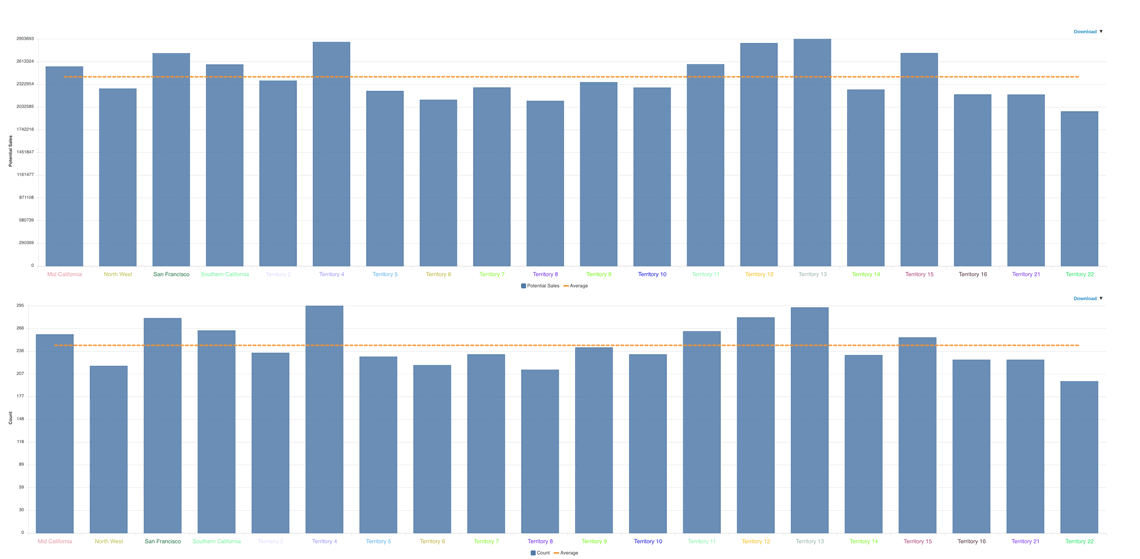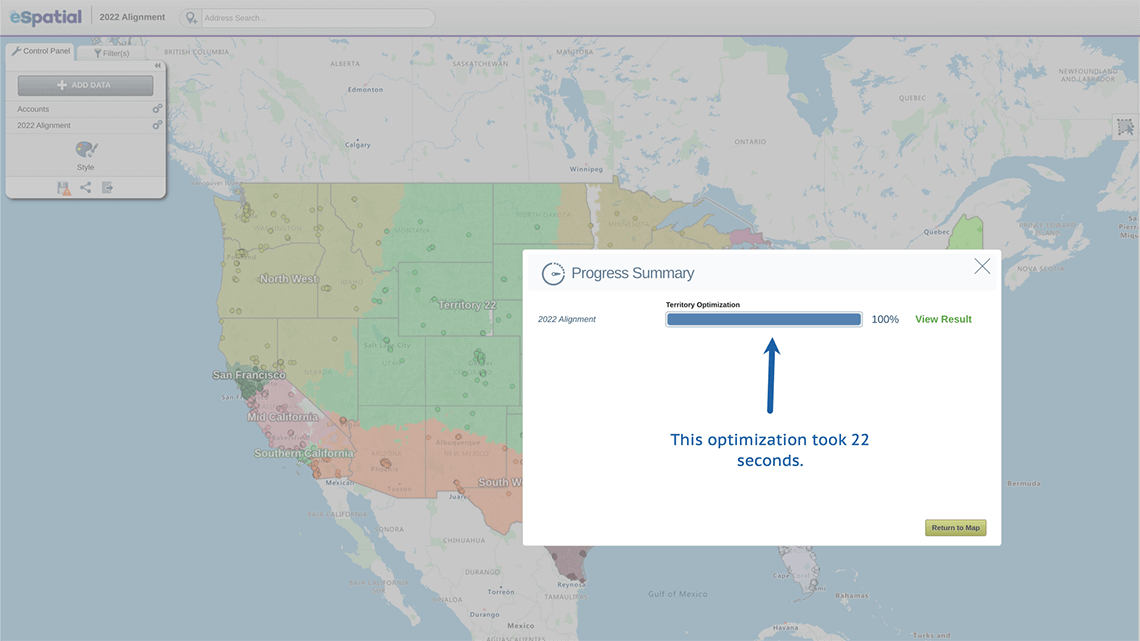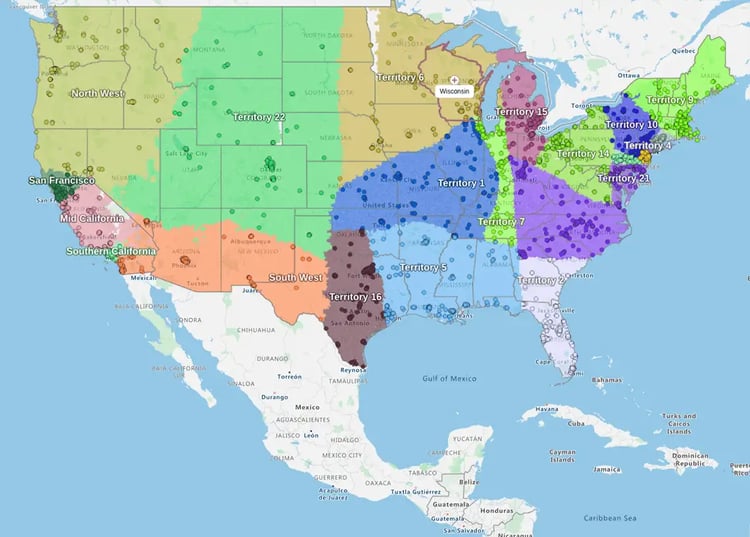Why you should balance sales territories

Territories balanced on potential sales
Territories balanced on customer count
Let's outline the downside to poorly balanced sales territories:
1. Some sales reps are underutilized others are overworked
That's bad because you may have sales reps who don't have time to maximize sales territory potential (more on sales potential below. Or you have reps who have too much time on their hands and may over-service accounts.
Not all customer accounts are made equal. Some are high-potential and highly profitable. Some (often your bottom 30%) are unprofitable and take up too many resources in both time and effort.
2. Rep turnover is higher
You might hear two scenarios when you view sales territory imbalances from your representative's perspective.
One is, "I love how you designed the sales territory to reward me. It has so much sales potential that I'll be hitting quota easily, without much stress".
The other is, "No matter how hard I work in this sales territory, it will never reward me. There isn't enough sales potential (quality customers and prospects) to earn a viable salary". Neither scenario is ideal for your organization.
3. Costs are higher
If you have sales territory imbalances, your service costs will be higher. Over-servicing comes with a financial penalty.
How to balance sales territories
- Calculate your sales potential
There are several ways to balance territories. Our recommendation is to start with calculating your sales potential. You may call it the total addressable (TAM) or serviceable (SAM) market. At its core, the sales potential represents growth opportunities, for you, your organization and your field based sales team. You may have a sales territory that hits quota regularly. Job done. Or is it? What if the quota is $10,000,0000, but the sales potential is $100,000,000? That extra $90,000,000 consists of competitor shares and untapped new customers or verticals. You know you won't achieve a 100% market share, but you set a 20% market share goal. So now you have a sales territory with a $20,000,0000 sales potential. An extra $10,000,000 in winnable market share and growth. That is what you should design your sales territory to exploit. - Calculate workload or an effort index
Workload or effort measures the time and resources available to service your sales territory effectively. The formula for workload is:
(Call duration time + Travel time) x Call frequency
If it takes 60 minutes to make a sales call. There are 30 minutes of travel to the call. And you call on the account 12 times a year. Your workload for that account is (60 +30) X 12. 1080 minutes or 18 hours.
If you have 100 similar accounts, your annual workload is 1,800 hours.
A simple example
A simple example would be a rep with a maximum call capacity of 4 sales meetings daily, or 20 per week. Assuming 48 working weeks a year, the maximum workload capacity available is 960 sales meetings.
But, and it is a big but. The rep has 150 accounts to service. And business policy is that every account gets 12 calls per year. That is a workload expectation of 1,800 sales meetings per year or 840 sales meetings the rep cannot attend. Your goal is to ensure that sales rep capacity is balanced. You want to maximize sales territory coverage and revenue while maintaining high customer service levels.
A complex example
We will use a spreadsheet and tackle a more complex workload calculation, calculating your total sales capacity per rep. Below we added:
- Total working days per year – We are assuming 260 days
- Administration days per year (if applicable)
- Meetings conference days per year
- Holidays
- Sick days


NOTE – the spreadsheet will calculate total selling days per year, assuming 35% of a sales rep's time is selling time, and 65% is non-selling time.
Daily sales call capacity
You will need to update your rep daily sales capacity.

You now know your annual sales capacity per rep (the maximum number of monthly sales meetings possible).
Account profiles
If you have an account grading system (we are using A, B and C), update the numbers by account type.

Call frequency
Update the number of calls planned by account type. For example, we expect all A accounts to get 12 sales calls yearly.

Call duration and travel time
Advanced sales territory mapping software like eTerritory will calculate your travel time using sophisticated algorithms. If you don’t have a sales territory management tool you can use an estimate for both travel time and call duration (how much time a sales meeting will take)

Revenue by account type
In the example below, we have added revenue by account type. The spreadsheet will give you an average revenue per hour generated for each account type.

Average revenue per hour provides insight and an opportunity to tweak call frequencies to generate more revenue for a sales territory.
For example, A accounts take up 72% of our sales call time but only generate 50% of our revenue. B accounts use 22% of our sales call time, generating 33% of our revenue. Reducing call frequency for A accounts and increasing it for B accounts should increase sales revenue.
You can develop multiple scenarios as you tweak your call frequencies to create a better workload balance.
NOTE – This rep has a workload imbalance of -94. That’s 94 sales meetings the rep cannot attend. What revenue potential are you losing?
How to create a balanced sales territory alignment
You'll need advanced sales territory mapping or management software like eSpatial. Using sophisticated algorithms, territory mapping software will calculate travel times for you. But you will need to know the call duration and the call frequencies:
Step 1 – Add your territory data


Step 2 – Add a weighted balance

Step 3 – Update your workload index

Step 4 – Decide on the number of sales territories to balance

Step 5 – Optimize and balance



Balanced, optimized sales territories
You have achieved your goal of balanced and optimized sales territories. Your alignments are balanced on sales potential and the number of accounts. And you have optimized them based on a workload index.

 by
by 